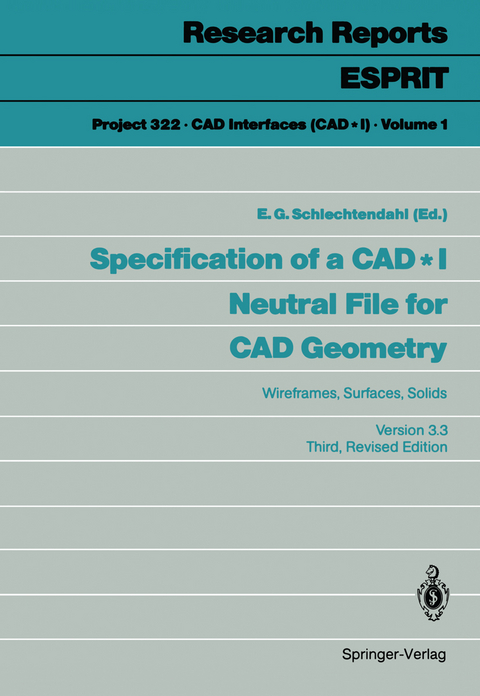Specification of a CAD * I Neutral File for CAD Geometry
Springer Berlin (Verlag)
978-3-540-50392-7 (ISBN)
ESPRIT Project 322, "CAD Interfaces", has been established to define the most important interfaces in CAD/CAM systems for data exchange, data base, finite element analysis, experimental analysis, and advanced modeling. The definitions of these interfaces are being elaborated in harmony with international standardization efforts in this field. One principal goal of the project is to develop techniques for the exchange of CAD information between CAD systems, and from the CAD domain to CAA (Computer Aided Analysis) and CAM (Computer Aided Manufacturing). This volume presents a proposal for a neutral file format for CAD data: curves, surfaces, and solids. The specification is based on a reference schema for CAD data bases and is defined informally with respect to its semantics and formally with respect to its syntax. This volume is a revised edition of "Specification of a CAD*I Neutral File for Solids" Version 3.2. The revision reflects the enhancements which result from the implementation of communication processors in eight different CAD systems and from the practical exchange of solid models between these systems. Due to the close interaction between the CAD*I project and the coming-up international standard STEP this specification also serves as an introduction to the geometry model that will be included in the future international standard.
to the Specification.- 1.1 Purpose.- 1.2 The relation between this proposal and STEP.- 1.3 Stucture of the document.- Approach.- Basic principles.- 3.1 Use of formal languages.- 3.2 Informal description of the CAD data schema.- 3.3 The physical level.- 3.4 Validation of the CAD model transfer.- Reference Manual.- The high level data specification language HDSL.- 4.1 Type declaration.- 4.2 Predefined types.- 4.3 Composite types.- 4.4 The types Reference,Ref_Only.- 4.5 Generic types.- 4.6 The predefined function Dimension.- 4.7 Rules applying to building a schema with HDSL.- 4.8 Semantics of reference models defined with HDSL.- The CAD*I reference model specification.- 5.1 Attribute types for general use.- 5.2 General data base structure.- 5.3 Referencing mechanisms.- 5.4 Geometric model entities.- 5.5 Points and Curves.- 5.6 Surfaces.- 5.7 Geometry on surfaces.- 5.8 Boundary representations.- 5.9 Constructive solid geometry.- 5.10 Hybrid_Solid.- 5.11 General grouping mechanism.- 5.12 Placement and instancing.- 5.13 Test data elements.- 5.14 Miscellaneous.- 5.15 Parametric modeling.- 5.16 Extensions of the reference mocel under consideration.- Levels of schema implementations.- 6.1 The geometric modeling levels.- 6.2 The assembly structure.- 6.3 Parametric models and macros.- 6.4 References.- The physical layer.- 7.1 The physical level.- 7.2 The metafile level.- 7.3 The alphabet level.- 7.4 Tokens of the neutral file language.- 7.5 The statement level.- 7.6 Rules for translating from the HDSL into BNF.- 7.7 Structure of the neutral file language.- Implementation Guidelines.- Definition of the state machine post-processor.- 8.1 The finite state approach.- 8.2 Interpreter.- 8.3 World.- 8.4 Entity with scope (expect World).- 8.5 Begin scope definition.- 8.6 End scope definition.- 8.7 Close entity.- 8.8 Entity world.- 8.9 Property definition.- 8.10 Interpertation of argument lists (expect references).- 8.11 References.- 8.12 Examples of error messages.- State lists.- Relationships between operating systems and CAD.- 10.2 Data bases and libraries.- Programming rules for CAD*I processors.- 11.1 Programming language.- 11.2 Software design.- Programming interface.- 12.1 Mapping of HDSL data types onto Fortran.- 12.2 Application program interface routines.- Comments on pre-processors.- 13.1.1 Implementation of level 1 and level 2 per-processor routines.- Comments on post-processors.- The interface of the CAD*I parser.- 15.1 Parse tree.- 15.2 Example.- Appendix A. The graphical alphabet.- Appendix B. The escape sequences.- B.1 The Latin alphabet (ISO6937).- B.2 The Greek alphabet.- B.3 The Kanji alphabet.- Appendix C. Alphabet translation into a private alphabet.- Appendix D. A neutral file for fixed format letters.- Appendix E. Examples of a CAD*I neutral files.
| Erscheint lt. Verlag | 12.10.1988 |
|---|---|
| Reihe/Serie | Project 322. CAD Interfaces (CAD*1) | Research Reports Esprit |
| Zusatzinfo | XV, 242 p. |
| Verlagsort | Berlin |
| Sprache | englisch |
| Maße | 170 x 244 mm |
| Gewicht | 485 g |
| Themenwelt | Informatik ► Weitere Themen ► CAD-Programme |
| Technik | |
| Schlagworte | CAD • CAM • Computer-Aided Design (CAD) • Computer-Aided Manufacturing (CAM) • Data Exchange • data structures • Design • interfaces • Manufacturing • Model • Modeling • operating system • programming • Semantics • Testing • Validation |
| ISBN-10 | 3-540-50392-7 / 3540503927 |
| ISBN-13 | 978-3-540-50392-7 / 9783540503927 |
| Zustand | Neuware |
| Haben Sie eine Frage zum Produkt? |
aus dem Bereich




